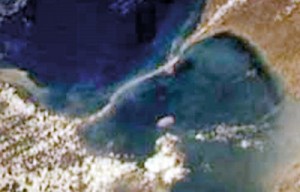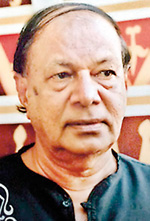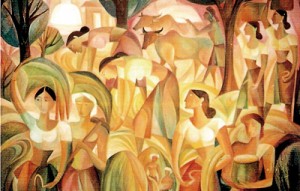Columns
India’s new 5-billion-dollar one-way Hanuman Bridge to Lanka
If the very thought of the ancient mythological Hanuman bridge connecting India with Lanka which enabled Rama to freely walk in and destroy Lanka’s Ravana was not enough to give one the Ramayana creeps, then the new Indian plan to build a 21st century Ram Sethu to Lanka must positively give the island nation the Maha Bharatha shudders.
India’s decision to revive the plan to link Lanka to her mainland first received prominence when the Indian Road Transport minister Nitin Gadkari announced it after the signing of the Bangladesh, Bhutan, India, Nepal motor vehicle agreement in Bhutan this June.

NASA Space Image: The Hanuman Bridge as seen from above
“The Government,” he declared, “is also looking at connecting India and Sri Lanka. The road connectivity, built across Palk Strait, could possibly be a combination of a sea-bridge and underwater tunnel.”
The plan unveiled was to build a 23 km sea bridge linking India’s Dhanushkodi to Lanka’s Talaimannar. The project was presented by the Indian minister as one that was vital to “increase the trans-SAARC road and transport network,” The cost for the bridge: 5.19 billion US dollars.
Last Sunday the Press Trust of India, the country’s largest news agency, reported India’s plans to build the bridge following the ‘meeting Nitin Gadkari had with Sri Lankan Prime Minister Ranil Wickremesinghe last week with plans to expand the existing motor pact with Bangladesh, Bhutan and Nepal to other neighbouring countries.’
Ranil Wickremesinghe, however, on Wednesday denied that any discussion had been held regarding building a bridge. Briefing parliament on his recent visit to India, he stated, “There were no such talks. These reports are meant to mislead the people.”
But India has already done her groundwork. She has already laid out the engineering plans for the bridge. She has already held discussions with the Asian Development Bank (ADB) to raise the 5.19 billion dollar loan for the ambitious project. Indian officials say ADB has already expressed interest, having already agreed to finance infra structural projects worth $8 billion under Bangladesh, Bhutan, India and Nepal (BBIN) Motor Vehicle Agreement. In short, the entire gamut of the whole project has been finalised by India, It has been wrapped lock, stock and barrel; and is now ready to be presented to Lanka as a fait acommpli.
 And next month in October, India is set to engage in high-level talks with Lankan officials to apprise Lanka about the developments related to implementing the project under BBIN Motor Vehicle Agreement. And then India wants Lanka to join it and become part of the ambitious Trans-Asia highway.
And next month in October, India is set to engage in high-level talks with Lankan officials to apprise Lanka about the developments related to implementing the project under BBIN Motor Vehicle Agreement. And then India wants Lanka to join it and become part of the ambitious Trans-Asia highway.
But evidently the plan for a bridge to link up Lanka has been on the drawing boards for some time. In March this year when Indian Prime Minister visited Lanka and addressed Parliament he quoted a line from the song ‘Sindu Nadiyin Misai’ composed by Tamil poet Subramanya Bharathi. The line he chose was ‘Singalatheevukkinor paalam ameippom’ (we shall construct a bridge to Sri Lanka). He then declared, ‘I have come with the hope of building this bridge.” The following day Modi was at Talaimannar, the Lankan bank of the planned bridge where he flagged off the train on the Indian built northern rail track.
Only now does Modi’s meaning become clear. It wasn’t the figurative reaching out to Lanka’s heart, to build “a bridge that rests on strong pillars of shared inheritance; of shared values and vision” that he was referring to. Rather, he was affirming India’s commitment to the building of a 5 billion dollar mammoth steel and concrete structure spanning 23 km over the Indian Ocean to literally bring the two countries together as one: to tie Lanka to an umbilical cord that would link her to the navel of Mother India.
The concept itself is nothing new. It was the Ramayana, a Sanskrit epic poem written by poet Valmiki 2,500 years ago, which first makes mention of the bridge when it relates how the Indian Prince Rama with the help of Hanuman’s Monkey Brigade invaded Lanka after making a bridge over the Palk Strait waters to rescue his wife Sita held hostage by Lanka’s King Ravana. After Rama vanquished Ravana, the Monkey God Hanuman followed a scorched earth policy by setting Lanka on fire.
Inspired, no doubt, by the epic tale, the colonial British gave serious consideration to constructing a bridge to link India with Lanka. By 1894 they even had a plan named Indo Ceylon Bridge to connect the two countries with a land route through Rameswaram and Mannar. They had even done an actual costing. But though the rail tracks at either end were laid, the bridge itself was never built. Instead a daily ferry service was operated and it was found that this was the cheapest way to transport passengers.
Today as India stands poised to implement the grandiose plan to build a similar bridge, the reason offered so far by the Indians is that such a bridge will facilitate cross border movement of all types of vehicles in the region. In fact it had been Ranil Wickremesinghe who had first mooted the idea of a ‘land bridge’ when he was prime minister in 2001 on the basis “it would offer both sides huge economic benefits, with industry springing up on both ends of the project”. The reasons advanced were that to achieve the economic integration of Lanka with the southern part of the Indian Subcontinent the bridge was a necessity. But New Delhi had not been interested. And Jayalalithaa in Chennai had been totally against it.
But though the Indians had responded negatively or feigned disinterest, Wickremesinghe’s proposal may have stirred their curiosity to inquire further to the possible advantages it may hold for India. This has led India to resurrect the ‘bridge’ proposal not as a standalone link to Lanka but as part of a grandiose vision to have a motorway link to her immediate eastern neighbours Nepal, Bhutan and Bangladesh and also to Thailand through Myanmar, all neighbours of India’s implacable foe, China.
With the vast expansion of Chinese influence over Lanka — the only island nation to be a close neighbour of India and sited on its very doorstep — it became imperative to fill the 23 km corridor in the Palk Strait with a Land Bridge to make complete the Trans-SAARC Road and give India total hegemony over her neighbours. The bait to the nations involved is, of course, the supposed trade benefits easy access to markets would bring.
But until this El Dorado of SAARC nations unified as one on the lines of the European Union is realised here on Asian earth, what benefit will the bridge be to Lanka? Or will it be a one way highway for India to be used as a stepping stone in the middle of the sea to realise her strategic aims? Is the investment of 5 billion dollars yield an economically feasible return to either country? If it does for Lanka, then does economic gain outweigh her security concerns?
If not, then what on earth is the bridge for? Whatever possible good it may bring to big brother India, what possible benefit will come to Lanka by naively surrendering her territorial integrity for a pot of gold at the end of India’s rainbow road?
Britain survived for a thousand years due to it being a sceptred isle. Even during World War II while Hitler overran the borders of Austria, Poland, Belgium, France, Netherlands, Luxembourg, Romania, Yugoslavia, Serbia, Crete and Estonia like a knife through butter and even invaded Russia with impunity, he didn’t dare to cross the sea to invade his ultimate target the British Isles. The channel was an insurmountable bulwark.
Since 1802, there had been many attempts to drill a tunnel under the channel to link Britain with the European continent. But fear of compromising the security of the nation put paid to construction. It was only after Britain had entered the European Economic Community in 1973 and the necessity for an underground link became obvious to supplement the hovercraft cross channel ferry service, that the plan to have a rail tunnel received the go ahead from Britain’s PM Margret Thatcher in 1981.
But can the same be said of Lanka? Not even thirty years ago Lanka faced the threat of an invasion which was only averted by using diplomatic code and ‘inviting’ the Indian Army to come as a peace keeping force. Though at present Lanka’s good relationship with India is back on track, India’s condescending attitude and the superior air she adopts expecting Lanka to do her bidding at the drop of her hat, do not augur well for a relationship that should be founded on parity and not on muscle and size. Lanka is an island of 20 million with a land mass of 25,000 square miles compared to India’s 1.2 billion people living on a land mass of 1,222,559 square miles. Imagine helping to pave a bridge to make this giant’s access to Lanka even easier?
At any time, India may feel that her physical presence on the island is vital to safeguard her own national security and interests, especially with China’s strong presence in Lanka. Should she ever feel the need to do so at some future date, even twenty years hence, she would not have to face the inhibiting perils of a sea invasion. With a highway over the Palk Strait, an entire Indian Army Corp numbering a hundred thousand men, together with heavy equipment, armoured cars, tanks, mobile ammunition dumps could be in Colombo within six hours from the Indian mainland.
The Lankan Government should bear this in mind when next month India engages in talks to persuade Lanka to join the BBIN motorway agreement. It must be strongly impressed upon Big Brother Bharath who has a historical reputation for being a big bully that Lanka will not be able to share in the Indian dream and that it will strongly protest against any attempt by the Indians to build another Hanuman Bridge to connect with Lanka.
The UN’s Human Rights Commissioner’s hybrid court even if it does infringe Lankan sovereignty may only be a temporary affair that can be controlled. The Colombo Port City, for all the fears expressed about Chinese violations of sovereignty, will not ignite protests that cannot be handled. But the Hanuman Bridge, given its historical backdrop, contains the emotional powder to spark a full scale blast. If India is allowed to build her bridge, the Lankan Government would have burnt its boats.
The Government should do well to remember that the seas around Lanka is also a moat around the Lankan citadel and forms the first formidable defence against any invader. To allow India to erect a drawbridge and place it over the moat to freely walk over it and enter Lanka’s castle walls would tantamount to a sellout. India, though our closest neighbour, is best kept at arm’s length.
The only reason that would justify the bridge would be if, as former President J. R. Jayewardene once suggested in the 1940s, Lanka becomes another pranth of India, which Lanka will inevitably be if the bridge project is allowed.
It is also said that India, in order to placate the sentiments of the Lankan people, has decided to call the bridge, the Hindu-Buddhist Bridge. It should not be forgotten that both religions though practised here, originated in India and are 100 per cent Indian even as the Bridge will be Indian.
To give India, which already has command of the seas and air space over Lanka, road access also to march in to Lanka will be, as an old Sinhala saying goes, ‘like giving ladders to jumping Hanumans”.
| How Semage’s hand that paints fed UN hunger for aesthetic joy While Lanka baiting has been the chosen sport to occupy the inclinations of those habituating The Human Rights and Alliance of Civilisations Room at the Palais des Nations, the UN’s Geneva headquarters where the Human Rights Council sessions are presently held, down in the main hall of the same edifice, the work of Lanka’s artistic genius is on permanent display to be viewed as a joy forever.  Internationally honoured: Jasyasiri Semage Upstairs, where former Human Rights Chief Pillai once bayed for Lanka’s blood and sharpened her daggers which the present chief Zeid has now partially sheathed but still holds ever ready for the kill; where the Sword of Damocles has been strategically arrayed to dangle over the heads of successive Lankan delegates called to account for the blood and tears of war; downstairs, the artistic brush of a Lankan master spirit Jayasiri Semage has found expression of a nation’s yearning for peace and harmony and given artistic life to a canvas with a painting aptly titled ‘Hands that feed to protect the motherland.’ In placid hues and harmonious forms, it depicts the life of Lanka’s peasantry harvesting life sustaining rice. When it was first unveiled in 2002 at a public exhibition of Semage art held at the UN main hall, it so caught the eye of the then Director General of the United Nations and moved him to request the artist to donate it to the United Nations where it would be on permanent display in the main hall, where the art of Pablo Picasso had once graced. It was a singular honour for Jayasiri Semage, the self taught artist from Ambalangoda, a small fishing village in the south of Lanka who, though many a flower is born to blush unseen, managed to transcend the fog of obscurity to burst through to the sunlit realm and put Lankan art on the world’s easel. Jayasiri Semage needs no introduction to Lanka’s art connoisseurs. But the story of his art, his perseverance in painting through his lean years as an unknown artist, his dedication to his muse and the international honour finally bestowed upon him need to be retold, if only to inspire similar artists to bloom as the flowers they paint. “I was eighteen years old when I realised that all I wanted to do in life was to become an artist,” Semage says after just concluding another successful exhibition held at his studio in Mount Lavinia last Sunday. “I did not think of pursuing any higher studies or doing any orthodox job. Fate had already decided for me, I felt instinctively what my path would be and I knew it lay in my art and I determined to pursue it to the very end, no matter where it took me.” The path first took him to the offices of the Lankadeepa newspaper in 1957 where he worked as an artist for four years. Then at the invitation of D.B. Danapala, who had been the editor of the Lankadeepa but who had moved on to edit the Davasa newspaper founded by Sepala Gunasena in 1961, the young Semage moved to join the editorial staff of the Davasa and soon rose to become the chief artist of the sixteen newspapers and magazines published by Independent Newspapers Ltd.  HANDS THAT FEED: Lankan artist Semage's masterpiece on permanent display at UN's Geneva building's main hall “I was in charge of the Art Department and I used to oversee the layout,” said Semage recounting his early days. “I also did illustrations and organised the many promotional campaigns for the newspapers. I even did the ‘spot the difference’ cartoons for the Rivirasa, the company’s Sunday paper”. He worked at Davasa till the end but during this period held his first ever exhibition in Malaysia. From then on the artistic world was his oyster. “But my most unforgettable moment was being requested by the UN chief in Geneva for my painting to be displayed in the main hall, Semage says with a sparkle lighting his eyes. “It happened like this. In 2001 my friend and one of my biggest fans in Geneva called me, and asked me to think about the idea of holding an exhibition in Geneva. I agreed. But I was thinking of holding it at the Geneva UN building which I knew allowed master artists to hold exhibitions. Even Picasso had held an exhibition there. Hoping against hope I applied. Through the good offices of the then Lankan Ambassador Prasad Kariyawasam, I made an application to the UN chief for permission. He asked me to provide samples of my work, my art bio. So impressed was the UN chief with my work that he gave permission to use the hall free of charge.” “But there was one request,” Semage recounts with pride, “he asked me whether I would be willing to donate the painting ‘Hands that Feed’ to be on permanent display at the UN Main Hall. Of course I agreed. I was thrilled. With a single brushstroke Semage thus became not only the first Lankan artist to be allowed to hold his exhibition but also the only Lankan to have his painting on permanent display at the Palais des Nations’ main hall. Comforting to know that, even though the world had sought to blacken the Sinhalese with the brush of racial villainy in the past, it holds one Sinhalese in the highest esteem for his sublime art; and has enshrined his creation in the sanctum of its international temple. | |


Leave a Reply
Post Comment